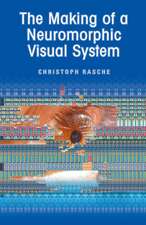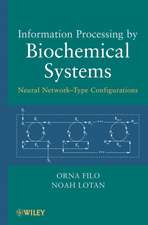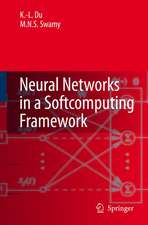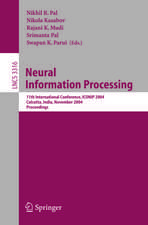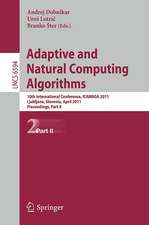Artificial Neural Nets and Genetic Algorithms: Proceedings of the International Conference in Portorož, Slovenia, 1999
Editat de Andrej Dobnikar, Nigel C. Steele, David W. Pearson, Rudolf F. Albrechten Limba Engleză Paperback – 14 iul 1999
Preț: 660.66 lei
Preț vechi: 825.83 lei
-20% Nou
Puncte Express: 991
Preț estimativ în valută:
126.41€ • 132.34$ • 104.60£
126.41€ • 132.34$ • 104.60£
Carte tipărită la comandă
Livrare economică 05-19 aprilie
Preluare comenzi: 021 569.72.76
Specificații
ISBN-13: 9783211833643
ISBN-10: 3211833641
Pagini: 372
Ilustrații: X, 352 p. 70 illus.
Dimensiuni: 210 x 280 x 20 mm
Greutate: 0.84 kg
Ediția:Softcover reprint of the original 1st ed. 1999
Editura: SPRINGER VIENNA
Colecția Springer
Locul publicării:Vienna, Austria
ISBN-10: 3211833641
Pagini: 372
Ilustrații: X, 352 p. 70 illus.
Dimensiuni: 210 x 280 x 20 mm
Greutate: 0.84 kg
Ediția:Softcover reprint of the original 1st ed. 1999
Editura: SPRINGER VIENNA
Colecția Springer
Locul publicării:Vienna, Austria
Public țintă
ResearchDescriere
From the contents:Neural networks – theory and applications: NNs (= neural networks) classifier on continuous data domains– quantum associative memory – a new class of neuron-like discrete filters to image processing – modular NNs for improving generalisation properties – presynaptic inhibition modelling for image processing application – NN recognition system for a curvature primal sketch – NN based nonlinear temporal-spatial noise rejection system – relaxation rate for improving Hopfield network – Oja's NN and influence of the learning gain on its dynamics Genetic algorithms – theory and applications: transposition: a biological-inspired mechanism to use with GAs (= genetic algorithms) – GA for decision tree induction – optimising decision classifications using GAs – scheduling tasks with intertask communication onto multiprocessors by GAs – design of robust networks with GA – effect of degenerate coding on GAs – multiple traffic signal control using a GA – evolving musical harmonisation – niched-penalty approach for constraint handling in GAs – GA with dynamic population size – GA with dynamic niche clustering for multimodal function optimisationSoft computing and uncertainty: self-adaptation of evolutionary constructed decision trees by information spreading – evolutionary programming of near optimal NNs
Cuprins
Plenary talks.- Topological Approach to Fuzzy Sets and Fuzzy Logic.- Linking Human Neural Processes Directly with Technology — the Future?.- Neural Dynamic Model for Optimization of Complex Systems.- I: Neural Networks — Theory and Applications.- Comparative Testing of Hyper-Planar Classifiers on Continuous Data Domains.- A Quantum Associative Memory Based on Grover’s Algorithm.- Newton Filters: a New Class of Neuron-Like Discrete Filters and an Application to Image Processing.- Improving Generalisation Using Modular Neural Networks.- The Role and Modelling of Presynaptic Inhibition in the Visual Pathway: Applications in Image Processing.- A Curvature Primal Sketch Neural Network Recognition System.- Using GMDH Neural Net and Neural Net with Switching Units to Find Rare Particles.- A Neural Network Based Nonlinear Temporal-Spatial Noise Rejection System.- Improving the Performance of the Hopfield Network by Using a Relaxation Rate.- A New Activation Function in the Hopfield Network for Solving Optimization Problems.- On-line Learning of Object Representations.- A Neural Network Model for Blast Furnace Wall Temperature Pattern Classification.- Monitoring an Industrial Plastic Injection Moulding Machine Using Neural Networks.- Rates of Learning in Gradient and Genetic Training of Recurrent Neural Networks.- Influence of the Learning Gain on the Dynamics of Oja’s Neural Network.- ATR’s Artificial Brain Project: CAM-Brain Machine (CBM) and Robot Kitten (Robokoneko) Issues.- A Speaker-Independent Arabic Isolated-Spoken Digits Recognition System Using Fuzzy Kohonen Clustering Network.- Control of Complex of Parallel Operations Using Neural Network.- Using Smoothing Splines in Time Series Prediction with Neural Networks.- Evolvable Hardware Chips for Neural Network Applications.- Direct Inverse Control of Sensors by Neural Networks for Static/Low Frequency Applications.- Centre and Variance Selection for Gaussian Radial Basis Function Artificial Neural Networks.- Minimum Square-Error Modeling of the Probability Density Function.- Adaptation of NN Complexity to Empirical Information.- The RBF Neural Network in Approximate Dynamic Programming.- Adaptive Modularity and Time-Series Prediction.- Some Comparisons between Linear Approximation and Approximation by Neural Networks.- II: Genetic Algorithms — Theory and Applications.- Transposition: a Biological-Inspired Mechanism to Use with Genetic Algorithms.- Genetic Algorithms for Decision Tree Induction.- Optimising Decision Classifications Using Genetic Algorithms.- Scheduling Tasks with Nonnegligible Intertask Communication onto Multiprocessors by Using Genetic Algorithms.- Design of Robust Networks of Specific Topologies Using a Genetic Algorithm.- The Effect of Degenerate Coding on Genetic Algorithms.- Genetic Algorithms for the Identification of the Generalised Erlang Laws Parameters Used in Systems Dependability Studies.- Multiple Traffic Signal Control Using a Genetic Algorithm.- Evolving Musical Harmonisation.- A Niched-Penalty Approach for Constraint Handling in Genetic Algorithms.- A Genetic Algorithm with Dynamic Population Size.- A Genetic Algorithm with Dynamic Niche Clustering for Multimodal Function Optimisation.- Time and Size Limited Harvesting Models of Genetic Algorithm.- A General Model of Co-evolution for Genetic Algorithms.- Selection of Informative Inputs Using Genetic Algorithms.- III: Soft Computing and Uncertainty.- Parallel Evolutionary Algorithms with SOM-Like Migration and Their Application to Real-World Data Sets.- Skewed Crossover and the Dynamic Distributed Database Problem.- Improved Pseudo-Relaxation Learning Algorithm for Robust Bidirectional Associative Memory.- Self-Adaptation of Evolutionary Constructed Decision Trees by Information Spreading.- Evolutionary Programming of Near-Optimal Neural Networks.- Exploring the Relationship Between Neural Network Topology and Optimal Training Set by Means of Genetic Algorithms.- Development of Fuzzy Learning Vector Quantization Neural Network for Artiflcal Odor Discrimination System.- Differential Inclusions Mapping Simplexes to Simplexes.- Crossbar Adaptive Array: The First Connectionist Network That Solved the Delayed Reinforcement Learning Problem.- An Evolutionary Algorithm for a Non-standard Scheduling Problem.- An Evolutionary Approach to Concept Learning with Structured Data.- Genetic Redundancy: Desirable or Problematic for Evolutionary Adaptation?.- Dynamic Systems Modelling with Evolving Cellular Automata.


